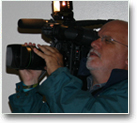
 |
  Trent University Archaeologists Uncover New Mayan Hieroglyphs in BelizeFOR IMMEDIATE RELEASE Discovery of ‘glyphs’ that name a previously unknown Mayan ruler have implications in ancient politics Monday, November 8, 2010, Peterborough A team of Trent University archaeologists led by Dr. Helen R. Haines has recently uncovered what is believed to be the name of a previously unknown Mayan ruler painted on the wall of a tomb located on the site of Ka'Kabish in North-Central Belize. “Part of the excitement is that glyphs on tomb walls are not known from this area of Belize,” explains Professor Haines, an assistant professor of anthropology at Trent University Oshawa, Thornton Road Campus. “While they have been found on monuments, the nearest documented glyphs painted on tomb walls are about 40 km to the west at the site of Rio Azul, in Guatemala.” Although translation is still on-going, Dr. Christophe Helmke, an epigrapher at the University of Copenhagen, believes that the glyphs record a name. Based on the tomb’s design and construction, Trent’s archaeologists believe that the individual was a person of importance and likely a ruler of the site. “The idea that the glyphs give us a name of whose tomb we are in makes the past come alive in a truly personal way,” says Prof. Haines. Built during the 5th Century A.D., the tomb was constructed with a corbelled vault, a cantilevered set-up that creates an inverted, v-shaped roof. The amount of effort involved in the construction of a vaulted roof signifies the elite status of the tomb. The size of the tomb, its location in the heart of a temple on the east side of the acropolis and the use of red paint on its walls are also indicators that the burial site would be that of a ruler. The discovery of a ruler in Ka’Kabish could imply that smaller sites such as this one were not as politically deprived as previously thought. It has long been believed that Ka'Kabish was simply a secondary administrative centre of the larger Lamanai political territory. The tomb of a ruler in this location suggests that there is much to learn about early-state political structures and hierarchies. “What is interesting about the Ka'Kabish tomb,” says Prof. Haines, “is that it is not like the ones known from Lamanai. It is more closely tied to the area further to the west, which may indicate that the Ka'Kabish rulers were aligned with different areas at different times.” This raises questions about the extent of rulers’ power in smaller sites such as Ka’Kabish. The Trent archaeological team led by Prof. Haines, who is based at Trent University Oshawa, Thornton Road Campus, is supported by a Social Sciences and Humanities Research Council of Canada (SSHRC) grant through Trent University. -30- For more information, please contact: Dr. Helen Haines, assistant professor of anthropology, Trent University Oshawa, Thornton Road Campus, (905) 435 x5100, helenhaines@trentu.ca |
































